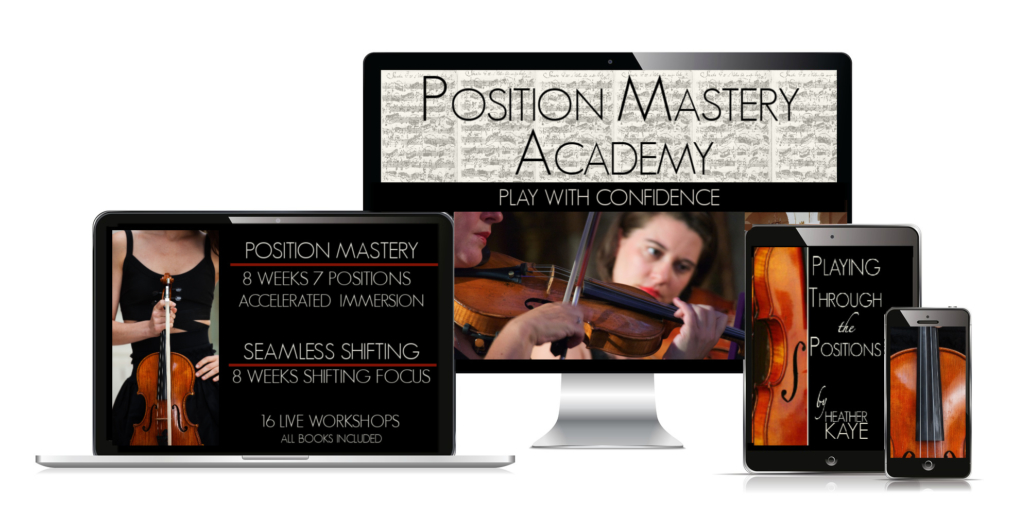How to Find High Notes on the Violin and Play with Good Tone
Do you have freakout moments when you see the super high notes on the page? When there’s so many ledger lines above the staff you just freak out like what the heck? I’m going to give you tips on how to figure out these high notes on the violin and play them with good tone.
If you’re new here, I’m violinist Heather Kaye giving you violin technique and tone tips every Wednesday at 8 AM CST.
Know Your Note Names
The first thing is, you want to know the names of the notes. So count your ledger lines above the staff in order to know the name of the note. If you don’t know the name of the note, you’re not going to know if you’re playing it in tune or not. So the note that was called for in this violin solo composition is a in ninth position. So I know it’s A and the second step is you want to know what position it is in. So I’m playing this a with second finger which means it’s in ninth position. My first finger is on G and I can check that with open G. You can always go an octave below and play an octave below. Get that in your ear so you can find that and hear very cleanly your G, your high G. Step number one, know your note name.
Know Your Positions
Step number two, know the position that you’re playing in.
Then as far as tone, we don’t want to use a really wide vibrato while we’re playing up here because when we play with the wide vibrato it really changes the pitch. When we play up higher on the violin the intervals get smaller, smaller and smaller so if you play with a wide vibrato you’re actually changing the pitch of that tone. We want to keep it very pure.
I would play without vibrato and make sure it’s super in tune then when you add vibrato, keep it very narrow, very tiny. It doesn’t need to be big by any means and while you’re playing up here you also want to make sure you’re comfortable. You’re going to have to have your elbow underneath the violin. Even in ninth position my thumb is still hanging out hooked onto the violin and I have a pretty wide stretch here between my thumb and my index finger to help myself play in a higher position.
When you play in these higher positions, you don’t want to play in such a way that your palm is sitting on the shoulder of the violin. It’s going to make it really hard to reach those notes. You want to play as if you were playing in first position with your palm facing the fingerboard. Even in ninth position my palm is still facing the fingerboard. I am able to have my thumb still hooked on with this wide stretch.
If you have a really small hand and you feel like you have to bring your thumb under, go ahead and do so but I would really encourage you to develop the stretch between the index finger and the thumb.
Is mastering violin positions on your to do list?
How many times have you said to yourself…”if only I had proper violin position training…” Well, if not now, when?
This is why I created violin positions & shifting academy where you don’t have to lose time to think what to practice or search for more violin position exercises. Your technical practice is all laid out for you. All violin position books included for you to see massive improvements even if all you have is 15 minutes a day of concentrated mindful technique practice.
Know the Role of the Bow
In order to play with good tone in the upper stratosphere you have to play closer to the bridge since the string length has shortened. When we play first position, the string is really long. When we get up into ninth position the string is really short. If your bow is not close to the bridge it will crack and not have a good tone. So you do need to bring your bow closer to the bridge.
Plus, it’s very important to play with straight bows. If you play with the crooked bow close to the bridge, again horrible screechy tone. Keep your bows really nice and straight.
You also want to make sure you have rosin on your hair of your bow. Remember not to play with tons of weight because it’ll screech as well. Keep a nice balanced weight, sustained but not too much. If it’s too light, it’s also not going to sound. Begin to experiment with your bow weight in order to know exactly how much weight that you’re playing with in order to produce a good tone.
Know Your Finger Distances
Then my final tip for you is to allow your fingers to push the other finger out of the way. For example, here this C to B is a half step and it’s really, really close.
I actually have to lift up my fourth finger and put my third finger right next to it in order to have that be in tune. So don’t be afraid to have one finger push the other out of the way because the intervals are so very close in the upper positions.
Those are my tips for you on how to find high notes on the violin and play them with good tone.
If you are ready to fill in the holes of your violin position training, study positions with me. Enroll in Position Mastery Academy, where you learn seven positions in eight weeks. All materials included.
I’ll see you there. Ciao.





Leave a Reply
Want to join the discussion?Feel free to contribute!